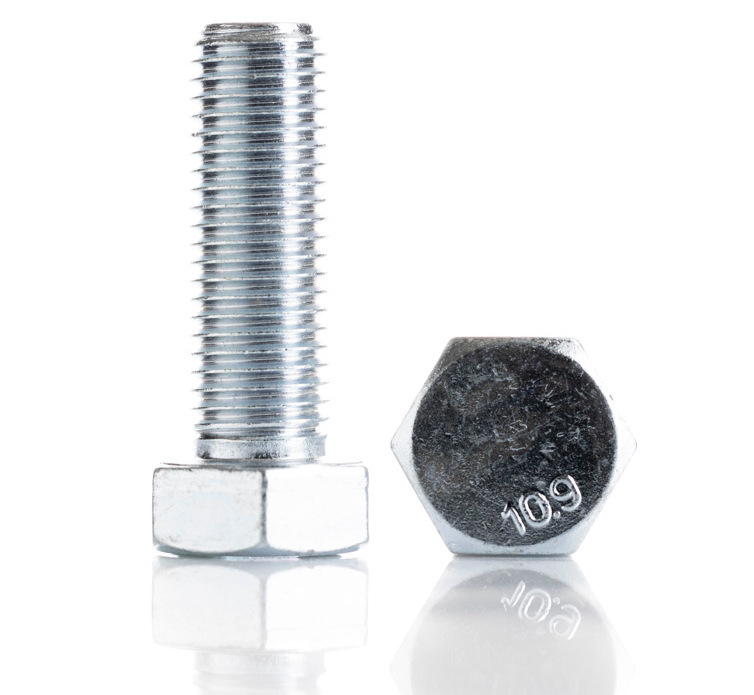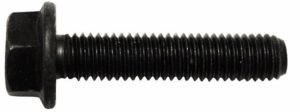
A bolt is a type of fastener, that is normally used together with a nut for assembling two unthreaded components.
The ease to use made them suited to play an important role in the development of mass-produced articles and steel structures.
It consists of a head and a cylindrical body that is externally parallel threaded along a portion of its length.
The head is the part of the bolt with the largest diameter and its shape is designed to fit the correspondent tightening tools. Bolts’ head can also perform other functions such as spreading the clamping load over the bearing surface or locking the bolt in place, stopping rotation.
The thread is a helical structure wrapped around the cylinder of bolts which is used to convert between rotational and linear movement, while ensuring the tightening of fasteners.
There are many forms of threads but two types are the most common. Spaced threads are used on woodscrews and self-tapping screws while machine screw threads are generally used on bolts and are designed to couple with preformed threads in nuts or tapped holes. Machine screw threads vary in accordance with helix shape and sizes, as specified in different international standards. For example the ISO thread (metric), Whitworth thread (in inches) or GAS thread (in inches).
Some kind of bolts have a thread that runs from underneath the head to the tip. However, bolts can be also partially threaded. That means they have an area, below the head, that is entirely free of threads. The length of this non-thread area, also referred to as bolt shank or shoulder, can vary depending on the type of bolt.
Both configurations offer a specific advantage in accordance with the use a bolt is intended to.
Fully threaded bolts spread the tightening tension along its entire length, with the largest holding pressure placed on the head, where it meets the material it fastens to. This kind of bots are the right choice when grip strength is very critical. Moreover, they rarely shear and tend to not loosen as well.
Partially treaded bolts are largely used when alignment and shear resistance are more important than grip strength.
The non-threaded segment, known as grip length, contains no weak points that could lead to cracking or bending. As tremendous forces are necessary to shear partially threaded bolts, they are suited for projects that require an additional force to hold metal parts in place. That is to say, on applications like motor mounts, water pulps, alternators and more.
Alike screws, bolts join the metal parts non-permanently. For instance, the parts can be separated from each other by using an appropriate tool. That is one of the main advantages of bolts in comparison with rivets that, for instance, they cannot be disassembled and reassembled again, for example.
Bolts are available in different configurations on the basis of their application and specifications.
VIPA offers a wide range of bolts in different materials such as carbon steel, stainless steel and brass. They can be also treated by means of metal coatings that provide an effective barrier protection against the most common corrosive agents.
Hex head bolts
 |
 |
Hex head Bolts are the most commonly used type of bolt for many applications, both in construction and in the repair industry.
They have progressively replaced the square head bolts over the decades because of ease of tightening.
They are mainly used for joints in pair with hex nuts and washers that help spread the load on the materials while avoiding bolt head being pulled through.
This type of head has a flat top surface, six flat sides and a flat bearing surface. The flat sides are designed to facilitate the tightening of bolts by means of a spanner or a wrench, enabling, at the same time, a high level of torque is applied to them, in comparison to other types of head.
Hex head bolts are produced in a range of property classes and materials and high-strength bolts are often manufactured with a hex head.
DIN 931 (partial thread hexagon head bolts) and DIN 933 (full thread hexagon head screws) are the international reference standards for hex head bolts with ISO metric coarse thread. The correspondent regulations, ISO 4014 and ISO 4017, define sizes “s” and “e” slightly different for diameters M10, M12, M14 and M22.
DIN 960 (partial thread hexagon head screws) and DIN 961 (full thread hexagon head screws) are the international reference standards for hex head bolts with ISO metric fine thread. Also in this case, the correspondent ISO standards, that is ISO 8765 and ISO 8676 define different sizes “s” and “e” about diameters M10, M12, M14 and M22.
Hex flange bolts
 |
Hex flange bolts are a one-piece hex-washer head bolt with a flat or a serrated bearing surface. These kind of fasteners are largely used, for example, to secure truck frames and provide several advantages.
The forged flange beneath the head spreads the load evenly over the bearing surface, thus eliminating the need for a washer.
Moreover, hex flange bolts are very useful when is to compensate the misaligned holes of parts being
fastened. Flange head bolts can be provided with serrations in the bearing surface in order to better lock the bolt in place.
Square Head Bolts
At one time, square head bolts were the industry standard of the fastening sector. Even though, nowadays, the have been largely replaced by the more easy-to-use hex head bolts, they are commonly employed for aesthetic reasons.
Carriage bolt
 |
Carriage bolts are a type of bolt specialised for use in woodworking, in particular, fastening metal to wood. However, carriage bolts are provided with a have a machine screw thread that make them equally suitable for metal applications. They are manufactured with a domed head, without any recessed drive type, and a square section immediately beneath it.
The square profile under the head is designed to fit with the correspondent square hole in the construction material, resisting rotation when the assembly is tightened using a nut.
Carriage bolts are also used for aesthetic reason because they provide a good-looking appearance to many applications due to their rounded head.
Structural bolts
Heavy hex structural bolts are designed for steel-to-steel structural connections. They are usually manufactured with a shorter shank than the standard hex bolt.